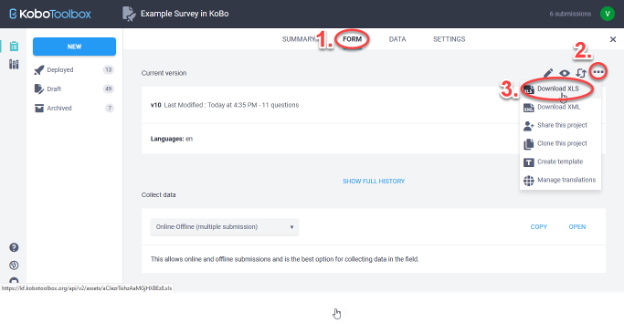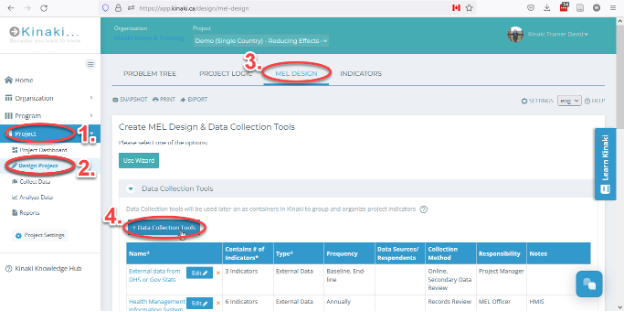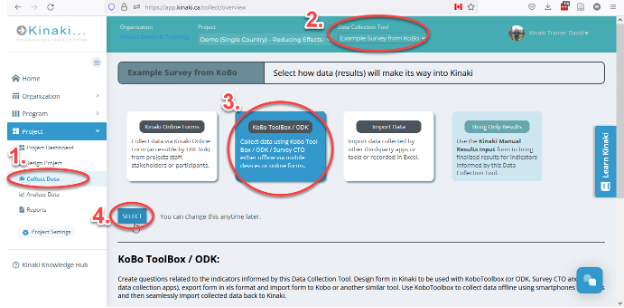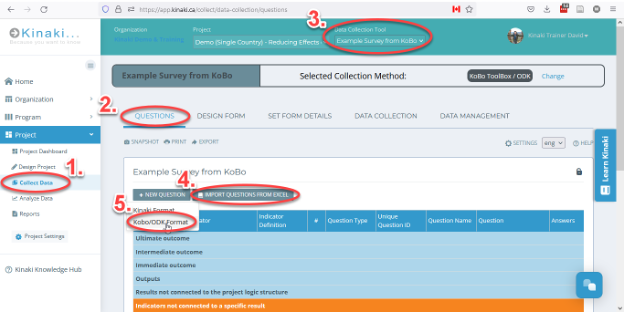When importing questions from Kobo to Kinaki, the method of import is connected to how you intend to eventually bring your data into Kinaki. Going through the options listed below will help you in making that decision:
Bringing questions from Kobo to Kinaki:
- If you don’t have any data in Kobo, and you will do data collection through Kinaki Online forms
- If you will also import data from Kobo to Kinaki, and discontinue using Kobo and use Kinaki Online forms for future data collection cycles
- If you will also import data from Kobo to Kinaki, and then continue to collect data from Kobo
Option 1
If you want to import questions/form from Kobo to Kinaki, and you do not have any data in Kobo and you plan on doing data collection through Kinaki Online Forms, you will follow this process:
If your DCT has less than about 10 questions, it might be more efficient to just re-create the questions (e.g. using copy and paste) directly in Kinaki on Questions page – without using the import process.
If you have more than 10 questions, then importing the questions directly makes more sense. You will download the form in XLS from Kobo, and then import it to Kinaki. Let’s look at the step-by-step guidance.
The survey questions must be downloaded from Kobo as XLS (the XLS Form format) to be used in Kinaki.
In Kobo, on the project “Summary” page, choose “Form” tab (1).
From the list of actions on right, choose “More actions” by clicking on the three dots (2).
Choose “Download XLS” from the drop-down menu (3).

Open Kinaki and locate the project which will be using the Kobo dataset.
We recommend using an empty data collection tool to import questions
To create an empty data collection tool in Kinaki, go to “Project” (1), “Design Project” (2) and then “MEL Design” (3). Click on “+ Data Collection Tools” (4) and fill in details, and click on “Create”.

Go to “Collect Data” (1) from the left panel, choose the empty data collection tool created in the previous step from “Data Collection Tool” (2) drop down menu and choose “KoBoToolBox/ODK” (3) and click on “Select” (4)

On the Questions page upload the questions to Kinaki by going to “Collect Data” (1), choosing “Questions” (2) and then “Import Questions from Excel” (4). Select the “Kobo/ODK Format” (5) and under “Choose files” select the file with your form/questions downloaded from Kobo. Then match the languages (or their codes) from the form to you project languages and click on “Ok” and “Save Qs” .

Once the questions are in Kinaki, you can adjust questions and answers (e.g. fixing typos, making questions more clear etc.).
Your questions have been imported to Kinaki and now you need to follow steps for creating Online Forms, since you will be using Kinaki for collecting data.
You will design the from: Design Form, set the logical flow or order of your questions: Set logical Flow and launch the online form for data collection: Data collection
Option 2
If in addition to importing questions, you will also import data from Kobo to Kinaki, and discontinue using Kobo and use Kinaki Online forms for future data collection cycles, then you will follow this process:
Adopt the step-by-step guidance in the article: Kinaki and Kobo Toolbox: Data Import- Option 1 , which walks you through first downloading the form from Kobo and importing it to Kinaki (as done in option 1 above), and then importing data into Kinaki as well.
You can adjust questions and answers in Kinaki (e.g. fixing typos, making questions more clear etc.) once the import is complete. It is important to note that when you import the Kobo form first, Kinaki retains Question and Answer IDs, therefore, you will be able to match data imported in future from Kobo. However, we recommend, that you wait before making changes in questions and answers in Kinaki till all data is uploaded from Kobo.
Note: If changes have been made directly in the form in Kobo online (not in Excel and imported to Kobo) between various data sets (e.g. between the baseline and the following years), Kobo changes the question and answer ids, which makes it very challenging to match data sets in Kinaki or any other tool. In this case, please contact us so we may guide you with the process through a support call.
After the import of form and data are complete, since you want to proceed with future data collection cycles in Kinaki, follow steps for creating Kinaki Online Forms: design the from: Design Form, set the logical flow or order of your questions: Set logical Flow and launch the online form for data collection: Data collection
Option 3
If you want to continue collecting data in Kobo, follow the step-by-step guidance in the article on Kinaki and Kobo Toolbox: Data Import- Option 1 It is essentially the same as Option 2 above, but in this case since you are going to continue with data collection in Kobo, you do not need to create a Kinaki Online Form. You will import the questions from from Kobo to Kinaki only once, and then continue to import data into Kinaki after each data collection cycle.

